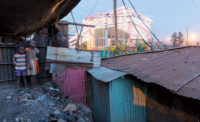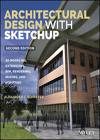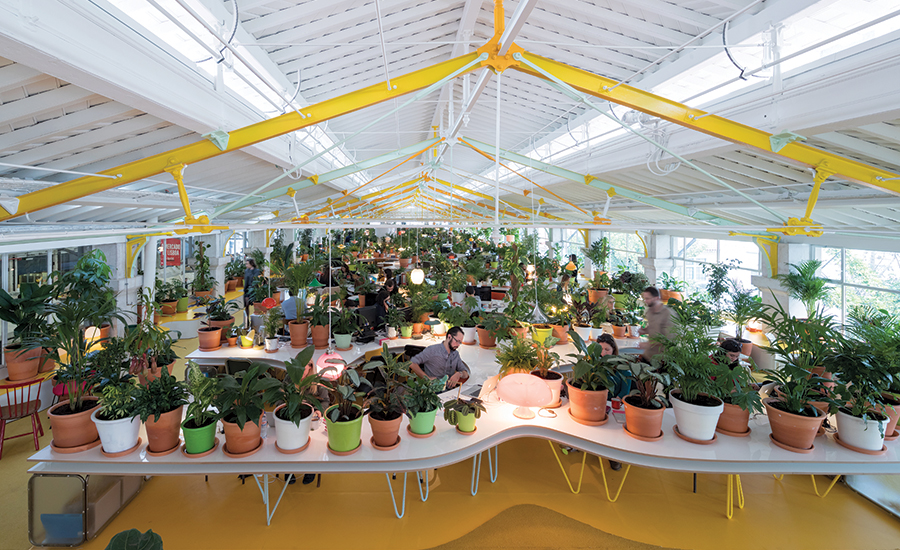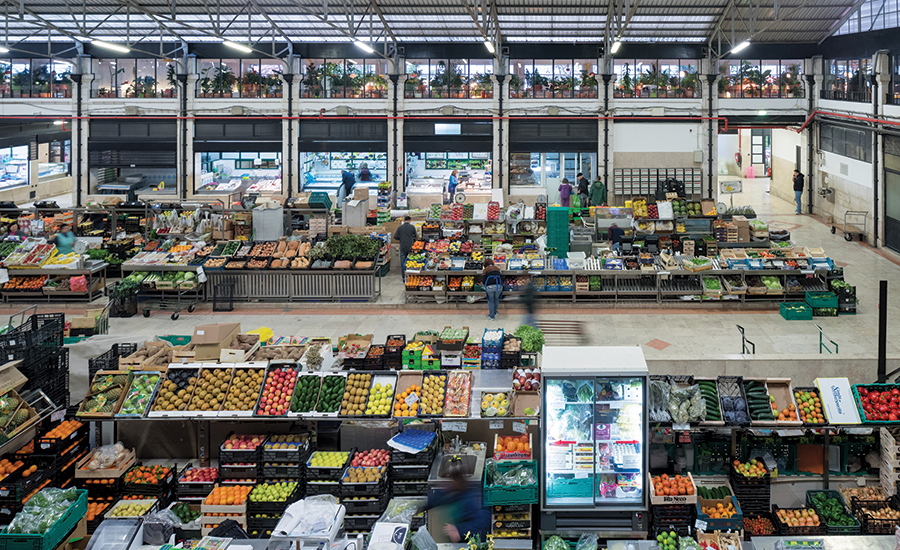Second Home by SelgasCano
Lisbon and London

Occupying the second floor of the Mercado de Ribeiro, the large, open work studio of Second Home Lisbon is filled with daylight from clerestories and windows overlooking the street and market. Abundant plants support well-being, reduce noise, and improve air quality beneath the cheerful hues of the newly painted existing structure.
Photo © Iwan Baan

Lisbon’s Mercado de Ribeiro, a handsome early 20th century open-span structure where a food market still functions daily. Second Homers look out over the busy stalls piled high with fruit and vegetables in the market’s central hall.
Photo © Iwan Baan

In Lisbon, a rich blue reception area welcomes visitors with cozy banquettes for small groups, transparent meeting rooms, and a bar.
Photo © Iwan Baan

In London’s East End, the original Second Home features bold enclosures of curved acrylic on the façade and throughout its colorful, plant-filled interior.
Photo © Iwan Baan

In London’s East End, the original Second Home features bold enclosures of curved acrylic on the façade and throughout its colorful, plant-filled interior.
Photo © Iwan Baan

Second Home Lisbon
Photo © Iwan Baan

Second Home Lisbon
Photo © Iwan Baan

Second Home Lisbon
Photo © Iwan Baan

Second Home Lisbon
Photo © Iwan Baan

Second Home Lisbon
Photo © Iwan Baan

Second Home Lisbon
Photo © Iwan Baan

Second Home Lisbon
Photo © Iwan Baan

Second Home Lisbon
Photo © Iwan Baan

Second Home London
Photo © Iwan Baan

Second Home London
Photo © Iwan Baan

Second Home London
Photo © Iwan Baan

Second Home London
Photo © Iwan Baan

Second Home Lisbon – Perspective
Image courtesy SelgasCano


















Architects & Firms
Designed to foster visionary work and attract a community of start-ups and well-established businesses, an innovative workspace dubbed Second Home has just opened in Lisbon. It occupies 12,000 square feet on the second floor of the city’s Mercado de Ribeiro, a handsome early 20thcentury open-span structure where a food market still functions daily. From one side of the space, Second Homers look out over the busy Cais do Sodre station where trains glide in and out. From the other, they see stalls piled high with fruit and vegetables in the market’s central hall.
Additional Information:
Jump to credits & specifications
This is the second space opened by entrepreneurs Rohan Silva and Sam Aldenton, who launched their first Second Home in 2014 on two levels of an art-supply warehouse in the Spitalfields area of London’s East End. The young partners wanted to turn the building into a different kind of creative epicenter, providing flexible work studios with easy come, easy go rental agreements. A place that could bring together fast-growing small businesses and the odd heavy hitters (Volkswagen has an innovation studio here) and where a bit of serendipitous crosspollination might happen. “We’re old-fashioned,” says Silva. “We believe in people meeting in the real world, but with ultra-fast broadband.”
Their choice of name, Second Home, indicates its noncorporate nature, as does their choice of architect for both locations: SelgasCano, a thoughtful practice based outside Madrid that believes in the joy of color and the practicality of low-cost materials. The firm’s 2015 Serpentine Pavilion (RECORD, August 2015) was made with iridescent ETFE stretched over a barrel-shaped frame. To insure that London Second Home has presence on the street, coprincipals Jose Selgas and Lucia Cano installed a dazzling yellow acrylic tube on the structure’s facade, then organized the interior with curving, clear acrylic walls and festooned it with plants.
Like its London counterpart, where every studio slot was rented before it opened, the Lisbon space—which accommodates 250 working members (who opt for varying levels of access to Second Home’s real estate and programs)— has a full complement of businesses, including one that extracts helium from the ground in Tanzania, a surf school headquarters, and a digital marketing agency. “Twenty per cent of members are business support people, like accountants and lawyers,” says Silva. “We don’t care what people wear or what they look like, but we want everyone to have something unique to contribute to the mix.”
The building’s upper zone had been used for storage. “I thought, all we need to do is clean and restore the trusses,” says Cano, pointing to the striking structural ironwork above the vast, white work studio, which they painted shades of yellow, pale green, and tangerine.
You reach the reception area via wooden stairs surrounded by panels of translucent acrylic in juicy shades of yellow and orange. “Transparency is important,” says Lucia Cano. “It brings lightness.” The walls and ceiling of of this area have been transformed by a rich Yves Klein blue paint, and the mechanical systems are hidden behind a curtain made of blue plastic rope. A curving banquette, upholstered in a durable plastic-coated yellow fabric, snakes beneath generous windows along the south wall—the perfect place for casual meetings. A central bar made of shiny white laminate serves excellent coffee.
The use of curves in SelgasCano’s architecture evokes the ethos of the brand: to offer a fluid environment where connections are to be made. Meeting rooms are formed by undulating, clear acrylic walls, and there’s not a sharp corner to be found on the contiguous desk hubs in the open-plan workspace.
As in London, this is a dense landscape of plants and chairs—over 1,000 of the first and 500 varieties of the second, many 20th-century classics. “I enjoyed weekends in Brussels, picking up vintage pieces at the flea market,” says Cano, who has also decorated the desks with residential and task lights from the past 80 years. The plants provide privacy and sound absorption, and also filter the air.
The architects are now turning their attention back to London, where the company acquired two more spaces, and created 45 extra studios in its original building on two additional floors. There are also plans to open in Los Angeles, with one secured property and one under discussion. “The weather is so good in L.A.,” says Silva. “We’ll be doing the opposite of London and Lisbon—taking the building outside instead of bringing nature indoors.” But the objective—to put design at the heart of this novel studio model—will remain.
CreditsArchitect: SelgasCano Spain
Personnel in architect's firm who should receive special credit: José Slegas, Lucía Cano, principals in charge Architects: Julio Cano, Bárbara Bardin, Inés Olavarrieta, Paola Tringali, Giulia Cosentino, Vicgor Jiménez, Ricardo Mancho, Barbara Pitto, Carolina Hidalgo
Consultants Environmental Engineers: Ritchie+Daffin Constructioon Site Management: Old2New
Furniture Design: SelgasCano / Secondhand Design Furniture
Photographer: Iwan Baan | iwan@iwan.com
|
Specifications |























